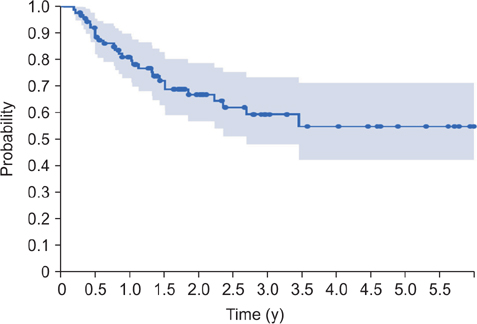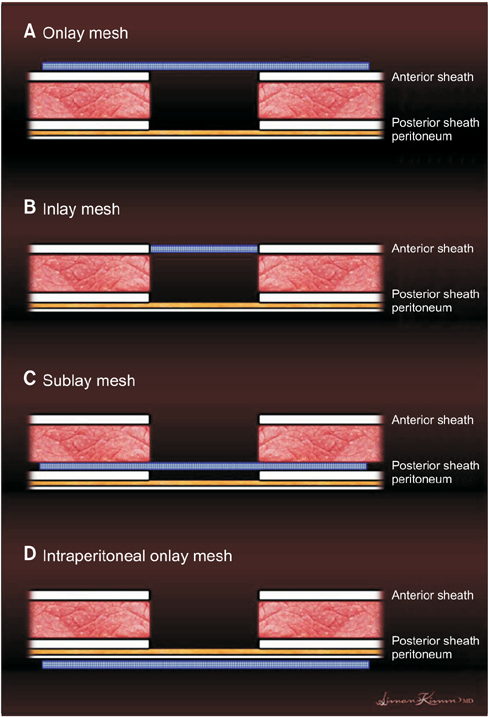Investig Clin Urol.
2016 Jul;57(4):240-248. 10.4111/icu.2016.57.4.240.
Parastomal hernias after radical cystectomy and ileal conduit diversion
- Affiliations
-
- 1Department of Surgery, Memorial Sloan Kettering Cancer Center, New York, NY, USA. bochnerb@mskcc.org
- KMID: 2426501
- DOI: http://doi.org/10.4111/icu.2016.57.4.240
Abstract
- Parastomal hernia, defined as an "incisional hernia related to an abdominal wall stoma", is a frequent complication after conduit urinary diversion that can negatively impact quality of life and present a clinically significant problem for many patients. Parastomal hernia (PH) rates may be as high as 65% and while many patients are asymptomatic, in some series up to 30% of patients require surgical intervention due to pain, leakage, ostomy appliance problems, urinary obstruction, and rarely bowel obstruction or strangulation. Local tissue repair, stoma relocation, and mesh repairs have been performed to correct PH, however, long-term results have been disappointing with recurrence rates of 30%-76% reported after these techniques. Due to high recurrence rates and the potential morbidity of PH repair, efforts have been made to prevent PH development at the time of the initial surgery. Randomized trials of circumstomal prophylactic mesh placement at the time of colostomy and ileostomy stoma formation have shown significant reductions in PH rates with acceptably low complication profiles. We have placed prophylactic mesh at the time of ileal conduit creation in patients at high risk for PH development and found it to be safe and effective in reducing the PH rates over the short-term. In this review, we describe the clinical and radiographic definitions of PH, the clinical impact and risk factors associated with its development, and the use of prophylactic mesh placement for patients undergoing ileal conduit urinary diversion with the intent of reducing PH rates.
MeSH Terms
Figure
Reference
-
1. Gerharz EW, Mansson A, Hunt S, Skinner EC, Månsson W. Quality of life after cystectomy and urinary diversion: an evidence based analysis. J Urol. 2005; 174:1729–1736.2. Donahue TF, Bochner BH, Sfakianos JP, Kent M, Bernstein M, Hilton WM, et al. Risk factors for the development of parastomal hernia after radical cystectomy. J Urol. 2014; 191:1708–1713.3. Liu NW, Hackney JT, Gellhaus PT, Monn MF, Masterson TA, Bihrle R, et al. Incidence and risk factors of parastomal hernia in patients undergoing radical cystectomy and ileal conduit diversion. J Urol. 2014; 191:1313–1318.4. Farnham SB, Cookson MS. Surgical complications of urinary diversion. World J Urol. 2004; 22:157–167.5. Kouba E, Sands M, Lentz A, Wallen E, Pruthi RS. Incidence and risk factors of stomal complications in patients undergoing cystectomy with ileal conduit urinary diversion for bladder cancer. J Urol. 2007; 178(3 Pt 1):950–954.6. Wood DN, Allen SE, Hussain M, Greenwell TJ, Shah PJ. Stomal complications of ileal conduits are significantly higher when formed in women with intractable urinary incontinence. J Urol. 2004; 172(6 Pt 1):2300–2303.7. Bloom DA, Grossman HB, Konnak JW. Stomal construction and reconstruction. Urol Clin North Am. 1986; 13:275–283.8. Fontaine E, Barthelemy Y, Houlgatte A, Chartier E, Beurton D. Twenty-year experience with jejunal conduits. Urology. 1997; 50:207–213.9. Israelsson LA. Parastomal hernias. Surg Clin North Am. 2008; 88:113–125.10. Janes A, Cengiz Y, Israelsson LA. Experiences with a prophylactic mesh in 93 consecutive ostomies. World J Surg. 2010; 34:1637–1640.11. Ripoche J, Basurko C, Fabbro-Perray P, Prudhomme M. Parastomal hernia. A study of the French federation of ostomy patients. J Visc Surg. 2011; 148:e435–e441.12. Martin L, Foster G. Parastomal hernia. Ann R Coll Surg Engl. 1996; 78:81–84.13. Marimuthu K, Vijayasekar C, Ghosh D, Mathew G. Prevention of parastomal hernia using preperitoneal mesh: a prospective observational study. Colorectal Dis. 2006; 8:672–675.14. Jänes A, Weisby L, Israelsson LA. Parastomal hernia: clinical and radiological definitions. Hernia. 2011; 15:189–192.15. Cingi A, Cakir T, Sever A, Aktan AO. Enterostomy site hernias: a clinical and computerized tomographic evaluation. Dis Colon Rectum. 2006; 49:1559–1563.16. Moreno-Matias J, Serra-Aracil X, Darnell-Martin A, Bombardo-Junca J, Mora-Lopez L, Alcantara-Moral M, et al. The prevalence of parastomal hernia after formation of an end colostomy. A new clinico-radiological classification. Colorectal Dis. 2009; 11:173–177.17. Serra-Aracil X, Bombardo-Junca J, Moreno-Matias J, Darnell A, Mora-Lopez L, Alcantara-Moral M, et al. Randomized, controlled, prospective trial of the use of a mesh to prevent parastomal hernia. Ann Surg. 2009; 249:583–587.18. Seo SH, Kim HJ, Oh SY, Lee JH, Suh KW. Computed tomography classification for parastomal hernia. J Korean Surg Soc. 2011; 81:111–114.19. Hong SY, Oh SY, Lee JH, Kim DY, Suh KW. Risk factors for parastomal hernia: based on radiological definition. J Korean Surg Soc. 2013; 84:43–47.20. Hotouras A, Murphy J, Power N, Williams NS, Chan CL. Radiological incidence of parastomal herniation in cancer patients with permanent colostomy: what is the ideal size of the surgical aperture? Int J Surg. 2013; 11:425–427.21. Keeling NJ, Ataullah CM, Wastell C. A survey of glove preferences of general and orthopaedic surgeons in North West Thames Regional Health Authority. J Hosp Infect. 1995; 30:305–308.22. Resnick S. New method of bowel stoma formation. Am J Surg. 1986; 152:545–548.23. Koltun L, Benyamin N, Sayfan J. Abdominal stoma fashioned by a used circular stapler. Dig Surg. 2000; 17:118–119.24. Pilgrim CH, McIntyre R, Bailey M. Prospective audit of parastomal hernia: prevalence and associated comorbidities. Dis Colon Rectum. 2010; 53:71–76.25. Klein EA, Montie JE, Montague DK, Novick AC, Straffon RA. Stomal complications of intestinal conduit urinary diversion. Cleve Clin J Med. 1989; 56:48–52.26. Pisters AL, Kamat AM, Wei W, Leibovici D, Liu J, Grossman HB, et al. Anterior fascial fixation does not reduce the parastomal hernia rate after radical cystectomy and ileal conduit. Urology. 2014; 83:1427–1431.27. Carne PW, Robertson GM, Frizelle FA. Parastomal hernia. Br J Surg. 2003; 90:784–793.28. Makela JT, Turku PH, Laitinen ST. Analysis of late stomal complications following ostomy surgery. Ann Chir Gynaecol. 1997; 86:305–310.29. Londono-Schimmer EE, Leong AP, Phillips RK. Life table analysis of stomal complications following colostomy. Dis Colon Rectum. 1994; 37:916–920.30. Leong AP, Londono-Schimmer EE, Phillips RK. Life-table analysis of stomal complications following ileostomy. Br J Surg. 1994; 81:727–729.31. Emmott D, Noble MJ, Mebust WK. A comparison of end versus loop stomas for ileal conduit urinary diversion. J Urol. 1985; 133:588–590.32. McGrath A, Porrett T, Heyman B. Parastomal hernia: an exploration of the risk factors and the implications. Br J Nurs. 2006; 15:317–321.33. Carne PW, Frye JN, Robertson GM, Frizelle FA. Parastomal hernia following minimally invasive stoma formation. ANZ J Surg. 2003; 73:843–845.34. Sjödahl R, Anderberg B, Bolin T. Parastomal hernia in relation to site of the abdominal stoma. Br J Surg. 1988; 75:339–341.35. Gögenur I, Mortensen J, Harvald T, Rosenberg J, Fischer A. Prevention of parastomal hernia by placement of a polypropylene mesh at the primary operation. Dis Colon Rectum. 2006; 49:1131–1135.36. Sohn YJ, Moon SM, Shin US, Jee SH. Incidence and risk factors of parastomal hernia. J Korean Soc Coloproctol. 2012; 28:241–246.37. Funahashi K, Suzuki T, Nagashima Y, Matsuda S, Koike J, Shiokawa H, et al. Risk factors for parastomal hernia in Japanese patients with permanent colostomy. Surg Today. 2014; 44:1465–1469.38. Goligher JC, Lloyd-Davies OV, Robertson CT. Small-gut obstructions following combined excision of the rectum with special reference to strangulation round the colostomy. Br J Surg. 1951; 38:467–473.39. Cuthbertson AM, Collins JP. Strangulated para-ileostomy hernia. Aust N Z J Surg. 1977; 47:86–87.40. Rubin MS, Schoetz DJ Jr, Matthews JB. Parastomal hernia. Is stoma relocation superior to fascial repair? Arch Surg. 1994; 129:413–418.41. Horgan K, Hughes LE. Para-ileostomy hernia: failure of a local repair technique. Br J Surg. 1986; 73:439–440.42. Janes A, Cengiz Y, Israelsson LA. Randomized clinical trial of the use of a prosthetic mesh to prevent parastomal hernia. Br J Surg. 20040; 91:280–282.43. Hammond TM, Huang A, Prosser K, Frye JN, Williams NS. Parastomal hernia prevention using a novel collagen implant: a randomised controlled phase 1 study. Hernia. 2008; 12:475–481.44. Lambrecht JR, Larsen SG, Reiertsen O, Vaktskjold A, Julsrud L, Flatmark K. Prophylactic mesh at end-colostomy construction reduces parastomal hernia rate: a randomized trial. Colorectal Dis. 2015; 17:O191–O197.45. Janes A, Cengiz Y, Israelsson LA. Preventing parastomal hernia with a prosthetic mesh: a 5-year follow-up of a randomized study. World J Surg. 2009; 33:118–121.46. Vierimaa M, Klintrup K, Biancari F, Victorzon M, Carpelan-Holmstrom M, Kossi J, et al. Prospective, randomized study on the use of a prosthetic mesh for prevention of parastomal hernia of permanent colostomy. Dis Colon Rectum. 2015; 58:943–949.47. Styrke J, Johansson M, Granåsen G, Israelsson L. Parastomal hernia after ileal conduit with a prophylactic mesh: a 10 year consecutive case series. Scand J Urol. 2015; 49:308–312.48. Nikberg M, Sverrisson I, Tsimogiannis K, Chabok A, Smedh K. Prophylactic stoma mesh did not prevent parastomal hernias. Int J Colorectal Dis. 2015; 30:1217–1222.49. Köhler G, Emmanuel K, Schrittwieser R. Single-port parastomal hernia repair by using 3-D textile implants. JSLS. 2014; 18:pii: e2014.00034.
- Full Text Links
- Actions
-
Cited
- CITED
-
- Close
- Share
- Similar articles
-
- A Fistula between Ileal Conduit and Iliac Artery after Radical Cystectomy with Ileal Conduit Urinary Diversion
- Ureteroappendicocutaneostomy(Appendix conduit): 4 Cases
- Functional Outcomes and Quality of Life after Orthotopic Bladder Substitution in Bladder Cancer Patients
- Safety of Adjuvant Chemotherapy after Orthotopic Bladder Substitution: Comparison to Ileal Conduit
- Alteration in Renal Function for Patients with Ileal Conduit and Ileal Orthotopic Neobladder




